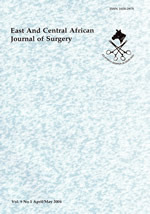
|
East and Central African Journal of Surgery
Association of Surgeons of East Africa and College of Surgeons of East Central and Southern Africa
ISSN: 1024-297X
EISSN: 1024-297X
Vol. 22, No. 3, 2017, pp. 29-35
|
 Bioline Code: js17030
Bioline Code: js17030
Full paper language: English
Document type: Research Article
Document available free of charge
|
|
|
East and Central African Journal of Surgery, Vol. 22, No. 3, 2017, pp. 29-35
| en |
Morbidity and mortality of paediatric burns patients at Maputo Central Hospital, Mozambique
Amado, Vanda; Da Rocha, Massada; Khosa, Dalva; Langa, Stella; DeUgarte, Daniel A. & Yohannan, Prem
Abstract
Background: The incidence of paediatric burn injuries is increasing in Africa. Paediatric
burn injuries are among the leading causes of preventable morbidity and mortality in sub-Saharan Africa. Research on the morbidity and mortality in this setting is much needed.
Methods: We conducted a prospective questionnaire-based analysis of paediatric burn
patients presenting to the Maputo Central Hospital during a five-month period. Interviews
were conducted with the children's caretakers by 2 paediatric surgery residents and 1
paediatrician at the Eduardo Mondlane Medical School in Maputo, with the aid of nursing
staff.
Results: Questionnaires were completed for 66 patients. Most burns occurred from scald
injuries (n = 46), particularly from cooking (n = 27) and bathwater (n = 19), followed by fire
injuries (n = 16). Burns occurred more frequently in the afternoon (n = 26) and morning (n
= 23). Many patients reported no adult caretaker present at the time of the burn injury (n =
24). Most burns were grade II (n = 49). Nearly half of the patients received a blood
transfusion (n = 30). One-third of the patients underwent operative surgical debridement (n
= 21). Skin grafting was performed on a subset of these patients (n = 13). A large number of
patients developed a wound infection (n = 39). All deaths occurred in patients who were
admitted to the paediatric intensive care unit and had sepsis (n = 9). The mean total body
surface area (TBSA) of burn deaths was 37% (range 20% to 50%), and many deaths were
secondary to fire burns (6 of 9; 66.7%).
Conclusions: Most paediatric burn injuries occur in association with domestic activities, such
as cooking and bathing. Adult caretakers are frequently not present at the time of the burn
injury. Mortality rates are high, especially for large body surface area burns caused by fire.
Educational programmes may help reduce the incidence of burns and the associated
morbidity and mortality. The improvement and expansion of emergency and intensive burn
care services may help to improve survival.
Keywords
burns; morbidity; mortality; paediatrics; paediatric surgery; Mozambique
|
| |
© Copyright 2017 - East and Central African Journal of Surgery
|
|
